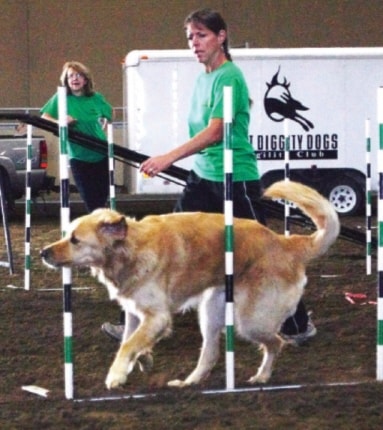Hot diggity dog they’re fast, flying balls of fur.
The Hot Diggity Dogs Agility Club held a demo competition at the Ponoka Community Fair.
“We go to all small towns, old folks homes and kids’ schools,” said club president Carol Allinson.
Each dog and handler was timed as they ran the course. They had to cover all the obstacles and each dog had to make their contacts, meaning they had to pass a certain point on the dog walk before they jumped off or they’d be disqualified.
The Hot Diggity Dogs weren’t just there to run the best time — they were there to entertain the audience and because both dog and handler love the sport.
After their competitive runs, youth volunteers from the crowd were introduced to the dogs and handlers and made up a portion of the agility dog barrel racing team.
During their second show at the fair the dogs also played musical chairs.
“Some of the dogs, we call them babies, are just learning,” said Allinson.
Allinson says agility is a sport dogs can start when they’re quite young. Training usually starts at six months with contacts tunnels, hoops and obedience. Dogs that young aren’t allowed to jump.
However, dogs aren’t allowed in the agility ring until they’re 18 months.
Agility dogs can compete in three skills levels: novice, open and utility. “By the time you get to utility your dog is probably six, seven or eight years old,” said Allinson.
There are different championships and titles dogs can compete for, such as jumper or weaver.
According to Allinson many of the club’s dogs are SPCA and rescue dogs. “They’re all really nice dogs. These dogs love doing this.”
Breeds of the Hot Diggity Dogs club range from a pug to a Belgian shepherd. Allinson says all dogs can compete in agility “there are no bad breeds,” but some are physically better suited than others.
Large breeds such as the St. Bernard would have a hard time because of their size and basset hounds because of their ears and long bodies, which can lead to back problems.
Molly the pug, who competed at the fair, is the size of a miniature schnauzer but jumps at a lower height because of a breed discrimination.
Pugs and bulldogs have the pushed up noses, which can create breathing problems. However, handler Crystal Van Eaton says Molly does well in agility because she was born with larger nostrils than most and didn’t need corrective surgery.
Allinson says that three-quarters of agility dogs are border collies.
She started out as a competitive obedience judge and teacher but she also wanted to try agility. “You kind of get hooked. I couldn’t quit.”
When a dog and handler are first breaking into agility the first thing they need is obedience to get the dog socialized. Obedience lessons can cost $135 to $140 for six lessons and other technique lessons, with Allinson, costs $135 for six lessons.
After the initial bout of lessons dogs will need many more, and before they’re allowed in the ring they must also have an association number.
